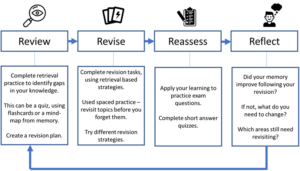One of the most challenging aspects of teaching is equipping students to be able to learn effectively on their own, outside of the classroom. This is particularly difficult when it comes to equipping students with the tools for effective revision. In this blog I will explore how we can equip students to become self-regulated learners through the use of retrieval practice.
Through our retrieval tracker we encourage the students to self-regulate by building their metacognitive skills. Students and teachers become aware of their strengths and weaknesses and can use this to target their revision.
Retrieval practice and revision
Once the use of retrieval practice is thoroughly embedded in lessons and students have started to see the benefits, I begin to strengthen their metacognitive skills by guiding them through developing their own retrieval strategies to use at home as part of their revision.
Students regularly struggle with the concept of revision and often have little idea about which strategies are the most effective. When students revise, they most commonly choose comforting techniques that give them a false sense of confidence, such as re-reading, highlighting or summarising notes (Karpicke et al., 2009). Students are put-off from practicing self-testing as this is more challenging than other strategies; however, the challenge is critical for effective learning and embedding it into the long-term memory (Agarwal, 2019). It is therefore important that students are exposed to the success of retrieval practice in lessons first and recognise that it has a positive impact on their learning, as this will then motivate them to complete revision through retrieval practice effectively.
Once students have seen the success of retrieval practice, they then need to be introduced to strategies they can use effectively at home. As with anything, these need to be modelled to the students and can also be strategies that are used in the classroom. Strategies can include:
- Mind-map with two colours – students make a mind-map of everything they can remember about a topic on a blank piece of paper using one colour. They then use their notes, revision guide or peers to add to their mind-map using a second colour. They then repeat this on a regular basis and will be able to see the progress of their long-term memory.
- Flash cards – students need to be taught how to use these as a self-testing tool and not as summary cards. Students can write a question or key term on one side and the answer or definition on the other. I also use these to help students remember key case study facts, where they write the name of the case study on one side (e.g., Shell Oil, Nigeria) and key facts on the other side.
The technique with the greatest impact, and that which I encourage my students to use the most, is creating their own retrieval practice quizzes. This technique is an excellent way for students to be able to target their areas of weakness, as well as use a range of question styles that go beyond just factual recall.
Through the regular use of retrieval questions in lessons, the students will have been exposed to a range of question types and I model to them how to use their notes & revision guides to create and then mark their questions. Once we have spent time in class doing this, students begin to write, complete and mark their own retrieval quiz once a week, using the retrieval quizzes in lessons to target their areas of weakness. One factor that is important is to ensure students leave at least three days between writing and answering the quiz to ensure they are retrieving the information from their long-term memory and not their short-term memory. This regular, spaced retrieval revision helps with long-term memory retention, expanding what they have learnt, not just preserving it and enables students to enter their exams with much stronger knowledge than if they had spent the night before cramming – due to their developed schema.
Using retrieval to self-regulate
In my previous blog I mentioned that students in my class have a retrieval tracker where they note down questions they got wrong and the areas they need to revise (Figure 1). The aim of this is for students to review their learning and identify gaps. They then go away and revise these gaps at home, using the retrieval strategies discussed above. Students then reassess their learning by applying their learning to a new context through practice exam questions or short answer quizzes. Finally, students reflect on their revision strategies and evaluate the impact of the strategies and which areas still need re-visiting (Figure 1). In this way, students are planning, monitoring and evaluating their both their learning and the strategies they are using to learn.
| Date | Score (/out of) | Area to revise |
Figure 1: Retrieval tracker
Through the use of this regular cycle (Figure 2), students are using retrieval practice both regularly and metacognitively, strengthening their long-term memory and developing their schema.
Figure 2: Revision cycle (Campbell 2021, with inspiration from internetgeography)
Jenny Campbell is the Subject Leader of Geography in a comprehensive secondary school academy in Coventry. Jenny has a PhD in Physical Geography, specialising in Quaternary climate change, and a Master’s Degree in Teaching Studies, where she developed a student-centred approach to metacognition and retrieval and spaced practice. Jenny is driven to inspire students from all socio-economic backgrounds, regardless of barriers to learning and their starting point, to have an impact on the world in which they live. A lover of teaching & learning, Jenny is a firm believer in research-informed teaching, and she is always looking for innovative improvements to refine her practice.
Complete Revision & Practice provides a revision guide, workbook and practice paper in one book, now with interactive recall quizzes, updated practice questions and video solutions.
Find out more about GCSE 9-1 Complete Revision & Practice




